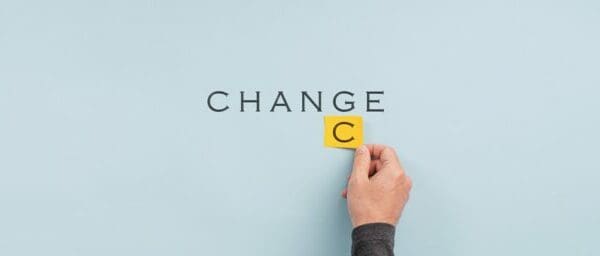Are You a Persecutor, a Rescuer, or a Victim?
The Drama Triangle is a model that shows the 3 roles of unproductive, intense, and potentially toxic relationships. The Persecutor, Rescuer, and Victim (PRV). The Triangle can help people adopt those three roles to escape from the dreaded drama triangle of conflicted relationships. They do this by knowing that firstly these roles exist and secondly how each role plays a part in the triangle. This is the drama triangle explained.
An Overview of What is Meant by the Drama Triangle
Wiki says,
The Karpman drama triangle is a social model of human interaction proposed by Stephen B. Karpman. The triangle maps a type of destructive interaction that can occur among people in conflict. The drama triangle model is a tool used in psychotherapy, specifically transactional analysis.
My understanding is that the Drama Triangle provides a model that helps us to initially understand relationships better – social interaction. Secondly, it can be used to compare that model of unproductive relationships to our own, to know whether our relationships are toxic, or not. To know whether our relationships are reactive and not empowered. Somewhat like a map showing us where we are, to then know where we want to be.
Understanding the 3 Roles Better; Persecutor, Rescuer, and Victim
Each role is unique and comes with its own feelings, sayings, desires and responsibilities. But, remember that these are unhealthy roles and are formed by habitual behavioural habits.
#1. Persecutors – “It’s all your fault.”
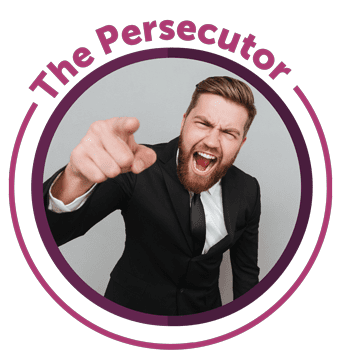
Examples of The Persecutor
In the examples above, our Persecutors were the Big Bad Wolf, Cal – the billionaire husband, and the Election moderator.
The Persecutor’s Role – Angry
Persecutors might also be called the villains, tormentors, betrayers, oppressors, or accusers. The role of a Persecutor is to blame. It is a shame-based role – the ‘shadow father principle’. Resembling a critical parent. All in all, They must always be right and by blaming they deny their vulnerability that they fear becoming a victim themselves. They criticise and blame.
Often this person received mental or physical abuse as a child. Persecutors are often secretly seething because they were ‘abused’ and have now decided never to be a victim again, and instead to be a survivor, and the only way to survive is to be anything but a ‘picked-on loser’. Their persecution is a means of protecting themselves by almost making the first strike.
A Persecutor’s ‘job’ is to keep the victim feeling oppressed – being a victim. Additionally, They don’t solve problems and their power is used negatively and can be very destructive – ‘I’m Ok you’re not – I put others down to feel ok’. Persecutors do not bend, and cannot be vulnerable.
If the Persecutor does not keep the victim oppressed the victim can rise up, and then the persecutor has no role, as the victim leaves the triangle. This role is the most extreme of the 3, though you can find more passive-aggressive persecutors.
Persecutor’s Sayings
- ‘It’s all your fault’.
- ‘They are wrong and I’m right’.
- ‘You can’t do anything right’.
- To the Victim: ‘You are to blame for all this going wrong’.
How to Recognise a Persecutor’s Personality
- Disparage other people’s worth
- Persecutes to feel superior
- Discounts others’ value and integrity
- Aggressive
- Angry
- Judgemental
- Critical
- Blaming
- Controlling
- Superior
- Hurts
The Relationship The Persecutor Seeks Out in the Triangle
The Persecutor seeks victims. By keeping a victim oppressed they keep themselves as the persecutor.
#2. Rescuers – “I’ll help you.”
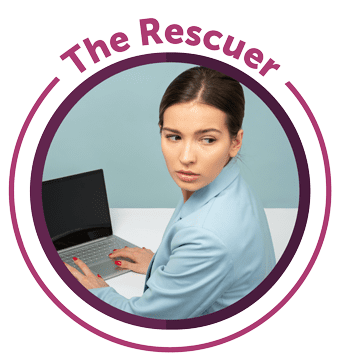
Examples of the Rescuer
In the examples above our rescuers were the Woodsman, Jack, and the American people.
The Rescuer’s Role – Fear
The Rescuers save people that they believe are vulnerable and they help without being asked. ‘I’m OK you’re not’ – I take on the victim’s responsibility to feel ok. Not my own.’ Altogether, rescuers want to care for other people and even need to do this to feel good about themselves, whilst neglecting themselves or not taking responsibility for their own needs. Furthermore, they want to feel valued and there’s no better way than to be a saviour.
Their belief is that if they take care of others, then eventually they will be taken care of. This is born from not having their needs met as a child. Believes that their own needs are not important and their only way of achieving value is to connect with others and rescue them.
Rescuers are overworked, tired, caught, stuck, almost a martyr-type style, whilst resentment builds beneath the surface. Their role is the extreme opposite of the Persecutor. They could be described as a shadow aspect of the mother principle, but instead of supporting and nurturing they control and smother, which is a misguided understanding of empowering.
They cannot allow the victim to get better or succeed because the victim would leave the triangle, which would stop their ability to ‘rescue’.
Rescuer Sayings
- ‘Let me help you’.
- ‘I can help you’.
- ‘You can’t do it on your own’.
- ‘Poor you, let me help’.
- ‘If they did what I say, they’d be happy’.
How to Recognise a Rescuer’s Personality
- Disparages other people’s skills
- Helps to feel superior
- Poor you
- Pain reliever
- Discounts others’ ability to think for themselves
- Enabler
- Keeps victim dependent
- Over-helpful
- Self-sacrificing
- Needs to be needed
- Rescues when it is not needed
- Feels guilty if they don’t rescue
- fears not being needed
- Keeps the victim dependent on them
- Discounts that the victim might be able to solve the problem themselves
#3. Victim – “Poor me.”
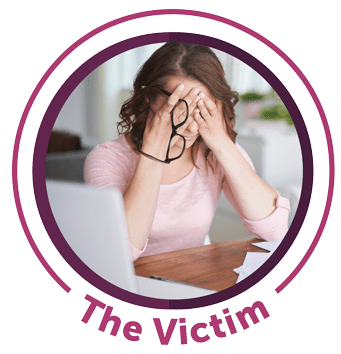
The Victim
In the examples above the victims were Little Red Riding Hood, Rose, and Donald Trump. Know that the Persecutor and the Rescuer fear the less desirable role of the Victim.
Victim’s Sayings and Self-Talk
- ‘Poor me. So unfair’.
- ‘It always happens to me’.
- ‘I never get a break’.
- To the Rescuer: ‘Only you can help me’.
The Victim Role – Sadness
Victims find themselves submerged in their own vulnerability, often evading the acknowledgement of personal responsibility for their circumstances. Moreover, they fervently deny any association with the negative situations they encounter and adamantly reject ownership of the power required to catalyse change within those very circumstances. Furthermore, victims display considerable difficulty in making decisions, resolving challenges, deriving joy from life’s offerings, and comprehending the intricate web of their own self-perpetuating behaviours.
‘I’m not ok, you are – I help others to feel ok.’
This role is a shadow of our wounded inner child. The innocent, vulnerable, and needy part of us. Criplling dependency on primary relationships. Broken and unfixable. Eventually, the one-down Victim becomes tired of being so and will look to level the playing field, which will mean that they seek to get even by becoming a persecutor (blaming others) or a rescuer (helping others).
How to Recognise a Victim’s Personality
- Disparages oneself
- Avoids responsibility to feel inferior
- Discounts self
- Powerless
- Hopeless
- Trapped
- Stuck
- Downtrodden
- Helpless
- Complains of unmet needs
- Dejected
- Child behaviour
- Discounts their own ability to solve the problem
- Dreams denied
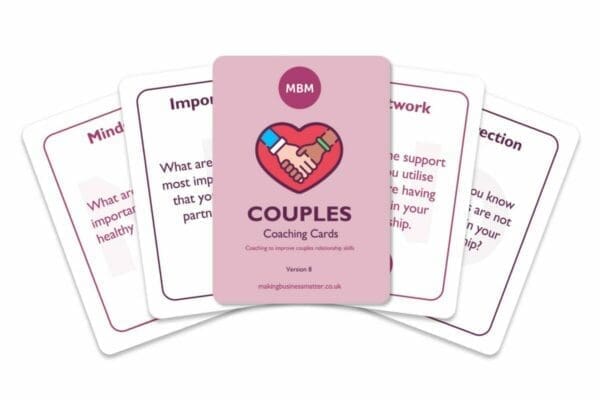
>> Couples’ Coaching Cards <<
>>Access on Amazon <<
The Drama Triangle Relationship Each Role Most Wants to Deal with
The Victim seeks the Rescuer, a saviour so that they can stay the Victim. If they approach that person and refuse to ‘save them’, the Victim can then turn them into a persecutor. Imagine the example:
– Victim: ‘I have no money because the government keep taxing me’.
– Desired Rescuer: ‘Everyone gets taxed. That’s just the way it is’.
– Victim: ‘You never lend me any money either. You want me to be unhappy’. The victim makes the Rescuer a Persecutor.
The Persecutor seeks someone to blame and the Rescuer seeks someone to save. Finally, each of the three roles is playing out its own dysfunctional pattern.
A Quick Background of How the Drama Triangle Was First Invented
First, we need to understand basketball and football fakes:
A ball fake in basketball is a technique used by an offensive player to distract the defender and also give the ball handler an advantage. A ball fake is executed when a player pretends to pass or shoot the ball in a convincing motion, but they do not actually let go of the ball.
Attributed to the ingenious mind of Stephen B. Karpman, M.D., the drama triangle emerged as his brainchild. It was during moments spent observing games of basketball and football from the sidelines that Karpman delved into his exploration. Also, he began by ‘…doodling with circles and symbols, engrossed in deciphering strategies that would enable quarterbacks to outmanoeuvre defensive halfbacks in football…’. This inventive inception paints a picture of the genesis of the drama triangle.
His father was a psychoanalyst who worked in a psychiatric prison hospital. A Russian scientist who studied with Freud and opened up a new field of criminal psychoanalysis. Also, he wrote 20 books and 100 articles.
Stephen Karpman, the son, attended Eric Berne’s Tuesday night seminar. Eric was a Canadian-born psychiatrist who created the theory of transactional analysis as a way of explaining human behaviour. Moreover, Berne encouraged his students to brainstorm by offering weekly credits for new theories. The first published theory of his work was called, ‘Fairy Tales and Script Drama Analysis‘ in 1968.
After Stephen showed Eric his original theory in 1968, Berne said, ‘Write it up and people will be quoting you for 200 years.’ Moreover, The Drama Triangle won the Eric Berne Memorial Scientific Award in 1972. Therefore, Berne was right. Forty years later the drama triangle is as useful today as it was then.
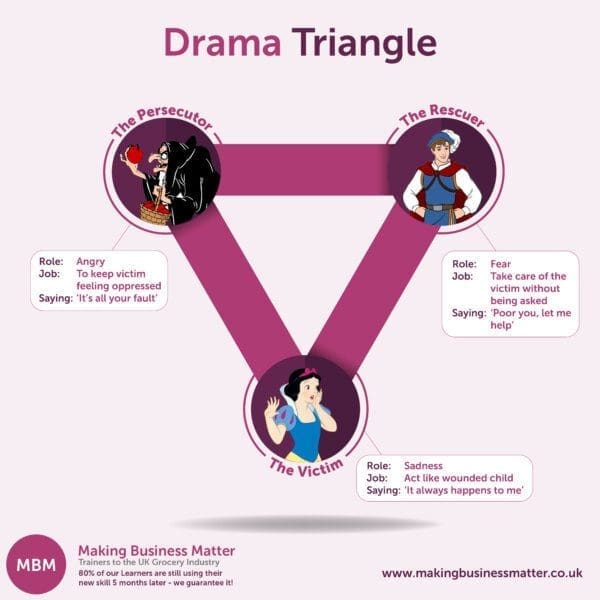
Details of How the Drama Triangle Karpman Works
The dreaded Drama Triangle is made up of 3 roles; The Persecutor, The Rescuer, and The Victim. Sometimes called the ‘Three Faces of the Victim,’ the triangle is also known as the ‘Victim Triangle’. The roles are also described as the two-up and the one-down roles. The persecutor, with the rescuer at the top of the triangle, and the victim at the top of the triangle.
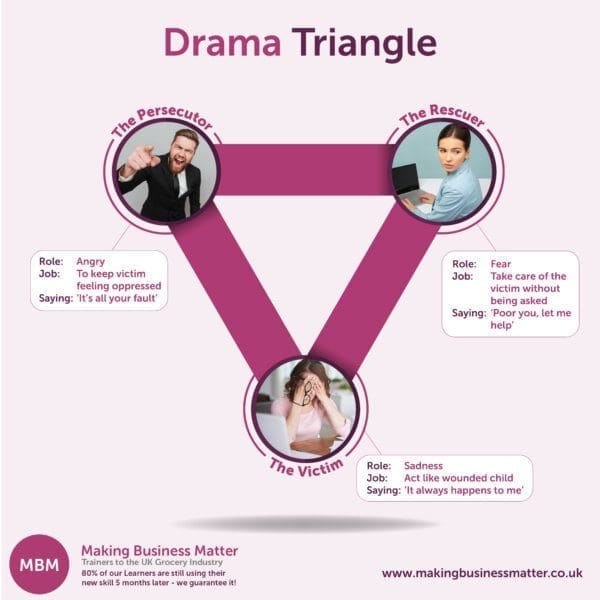
These 3 roles are in relationships that depend on each other. Relationships that are not productive will drain their energies with unhealthy interactions. Even if you are not playing one of these roles on a daily basis it is highly likely that you are dealing with people that are. Remember that these roles can be played consciously or subconsciously.
The trap is that people caught in the dreaded drama triangle want to meet their needs, which can be unconscious desires, rather than taking responsibility for the part they play in making the triangle a reality.
To bring this to life, let’s relate it back to something we know.
Here are Some Examples:
#1- Little Red Riding Hood
In this famous fairytale, Little Red Riding Hood is the Victim to the Persecutor, the Big Bad Wolf, and the Rescuer is the Woodsman. Moreover, the roles change through the fairytale. For example, Little Red Riding Hood was originally the Rescuer to her Grandmother and later became the Persecutor. More about roles changing later in this article.
#2- The Film Titanic
Within the intricate dynamics of this narrative, Rose assumes the role of the ‘poor little rich girl’, unequivocally embodying the archetype of the Victim. Additionally, Cal, the affluent oil tycoon set to be her husband, emerges as her Persecutor. Furthermore, Jack, whom society labels as ‘just a poor guy’, assumes the role of the Rescuer.
#3- Donald Trump
In the Presidential Elections, Donald Trump would often put himself forward as the victim. For example, ‘Oh, so I get less time to speak than him’. He was referring to Biden. In this case, the moderator was being put forward as the Persecutor, and Donald was hoping that the American people would be his Rescuer.
#4- Examples at Home
All of these examples are of the triangle relationship, also known as the emotional triangle. A more ‘at home’ example would be:
Mum and her young son are arguing about the state of his room. Dad comes home from work and says, ‘He’s had a long day at school. Let him off’. Here, Mum is the Persecutor, the son is the victim and Dad is the Rescuer. What follows can either be a continuation of those roles, or possibly a change of roles where Dad turns on Mum, and their son tries to rescue his Mum. Everybody switching roles.
If you consider your own life you will have played one of these roles at some point. It is very uncomfortable to admit, yet knowing that you have can be the very first step towards being happier. More about escaping from the drama triangle later in this article.
Benefits of Being in the Drama Triangle
Most articles you read will not share the benefits of being in the drama triangle because being in the triangle is seen as bad. Yet, we have all been part of the triangle more than we’d care to admit. So why have we?
Because in the triangle Persecutors can feel superior, Rescuers can feel good about caretaking, and victims get taken care of. What’s not to like?! The cost is that they continue with these unhealthy relationships. The Persecutors never get to properly challenge that achieves a positive outcome. The Rescuers never get to truly help someone long-term (Feed a man fish). And the Victims never get to help themselves.
Consequences of Drama Triangle Living
Living in the triangle is toxic, unhealthy, and is destined for misery and suffering. The cost for any of the roles living in this triangular existence is mental, emotional, and maybe even physical pain. As we chase ourselves around the triangle we live in reaction. Instead of living proactively, spontaneously, or with personal choice, we live in a world of action and reaction, which is dull, painful, and unhappy.
Moving from the Drama Triangle to the Empowered Triangle is a challenge for us all.
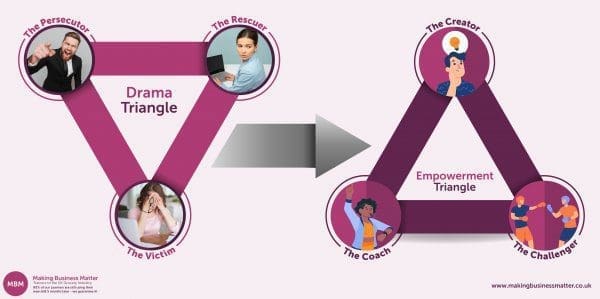
How We Move Between the 3 Roles of Persecutor, Rescuer and Victim
We each enter the triangle at our default. One of the 3 roles. This is our default and it is our identity. Our starting gate, and the role we take, define us and are generally crystalised in our childhood. This will be a well-trodden path and a familiar script used again and again to help us, be us. If you place the 3 roles on a horizontal line they would look like this:
Persecutor —— Victim ——— Rescuer
When you enter, you eventually become a victim. Moving from one of the 2 ups; either the Persecutor or the Rescuer and sliding downwards to the one down – the Victim. We all end up as victims. Powerless and helpless. That is one of the problems with entering the drama triangle, you always end up at the inevitable place of feeling sad, helpless, and powerless.
Karpman shared his thoughts on moving between roles using the fairytale of Little Red Riding Hood. In Little Red Riding Hood, the heroine starts as the Rescuer. Bringing food to her grandmother, who is the Victim. Then she becomes the Victim of the Big Bad Wolf, who is the Persecutor. Then, later Little Red Riding Hood becomes the Persecutor when she sews stones into the wolf’s belly, who has now become the victim.
Little Red Riding Hood plays all the roles of the drama triangle. The intensity of the drama increases the more switches she has. For example, if we are the persecutor blaming someone and then we switch to the victim, our feelings are even more pronounced. We were ‘comfortable’ blaming and now we’ve switched roles, with new thoughts, and new feelings, which are like riding an emotional rollercoaster. It takes its toll.
Moving Around the Triangle
Not only do we enter the triangle with people but in our minds too. We move around the triangle continually in our heads. Consider this example:
You miss the deadline for a project. First, you tell yourself off for being lazy and incompetent – assuming the role of the Persecutor. Then, you try to rationalise that you are only human and you did your best – stepping into the role of the Rescuer. Finally, you convince yourself that the company is overworking you and should provide more support – effectively taking on the role of the Victim.
The programme that continually plays in our heads perpetuates the drama triangle, thus becoming our very own shame-making machine. In an unhealthy cycle, especially in a world where mindfulness and mental health are increasingly essential, this triangle acts as an uncaring and destructive force, demanding our awareness.
What Causes the ‘Trauma Triangle’? (This is Another Name for the Drama triangle)
A drama triangle happens when a situation calls for someone to feel like a victim or a persecutor. They then take on one of these roles. This person then enlists the rescuer in the situation. Each role is acting selfishly to fulfil their needs, e.g. for the persecutor to blame someone.
How Do You Escape the Karpman Drama Triangle
Steering clear of the notorious drama triangle requires a conscious act of ‘putting your big boy pants on’, signifying the embodiment of maturity. Evidently, it entails assuming the role of a grown-up and exemplifying leadership qualities. This journey doesn’t involve the instinctual response of flight or fight but rather treads the middle path where making the right decision might feel discomforting, yet proves to be the optimal choice for all parties involved.
This transformation hinges on the realisation that you’ve inadvertently assumed one of these roles—a realisation that demands profound self-awareness. Additionally, the pivotal shift towards the ‘Empowerment Triangle’ serves as the ultimate key.
While the Drama Triangle serves as the stage for chaotic ‘drama’, the Empowerment Triangle paves the way for genuine empowerment. Moreover, It’s a transition from being entangled within the web of dramatic dynamics to shouldering accountability for your role in perpetuating them.
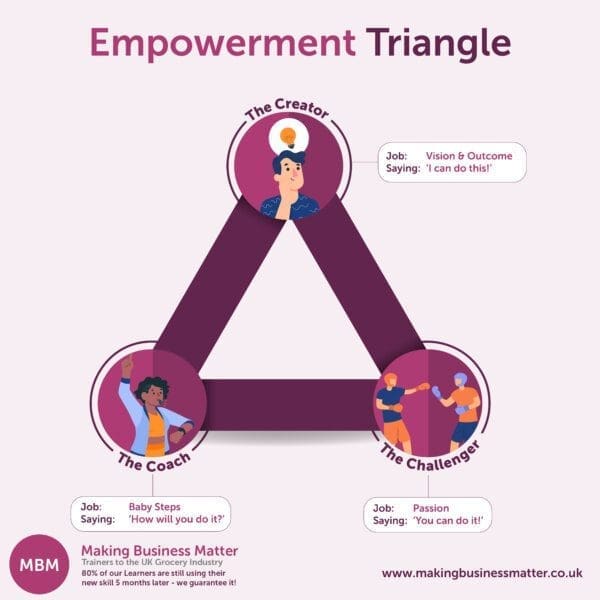
If anyone one person ‘wakes up’ from the triangle it can support all 3 roles moving out of the triangle. Particularly if the victim wakes up because that is the one-down role and arguably the toughest role to escape. The reason that one person can shatter the triangle is that it is a little like Batman and the Joker. Batman needs the Joker so that he can be a superhero. Without him, he has no role – they are codependent on each other.
Knowing You’re in it
The first step to escaping the drama triangle is to know that you are in it.
Admitting that you have adopted one of the three roles is hard but critical to moving forward. Train your internal observer to recognise the signs that you are becoming one of the three PRV.
The second step is to ask yourself, ‘What do I really want?’ – Do I want to move from reactive relationships to feeling empowered in your relationships?
The third step requires changes in your mindset and then your behaviours. From reacting to choosing. Tearing down to building up. From telling to asking. Focusing less on what you don’t want and more on what you do want.
Which role are you? A Prosecutor like the Wolf? A Rescuer like Jack? Or a Victim like Mr Trump?
We are Never Victims But By Choice
Once you know your default role read about what your role can do to escape the drama triangle:
I am a Persecutor But I want to be a Challenger.
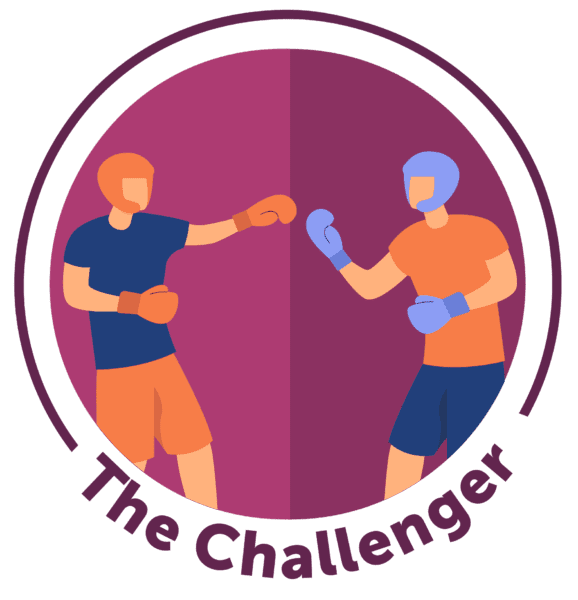
Accept that you are the ‘bad guy’. You have blamed. Kept a victim as a victim. This is your first step and it is a critical step and a hard step. Remaining where you are is easier, escaping is hard.
Your next step is to remain firm yet fair. Assertive – Not aggressive. See the victim as a person, and challenge them – don’t blame them. Additionally, hold people to account. For example, ‘If you hold up your end of the bargain, I’ll do the same’. You can do this. Ask yourself – who has been challenging and yet fair in your life? Use them as a role model. Finally, Be proud to help the victim learn and grow, with your support.
I am a Rescuer But I want to be a Coach
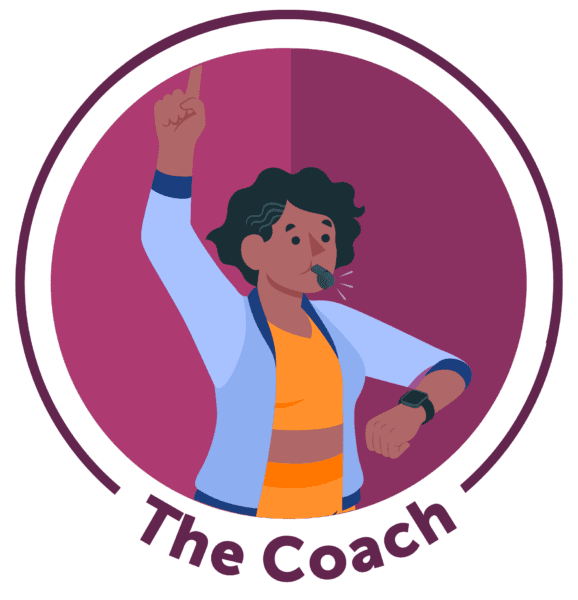
This phrase is most useful for escaping the Rescuer role:
Give a Man a Fish, and You Feed Him for a Day. Teach a Man To Fish, and You Feed Him for a Lifetime.
Help the victims to help themselves. Teach them. Coach them, and still care for them, but with agreement on boundaries of how much teaching and coaching you will do to help them. After all, they need to help themselves. Learning the GROW model will help you to begin. The very first step is to ask open questions and a good first question is to ask them, ‘What do you really want?’.
I am a Victim But I want to be a Creator
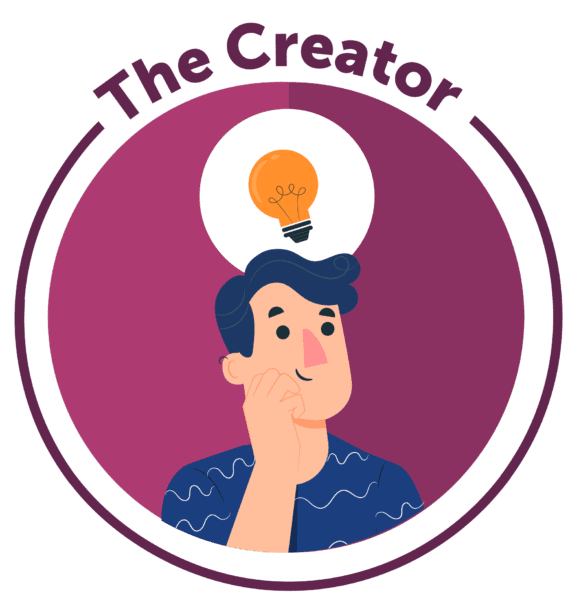
Embrace your vulnerability and transform into both a proficient problem solver and a resilient survivor. Equip yourself with an array of problem-solving techniques; among these, meditation can play a pivotal role. Take a moment to introspect, asking yourself ‘what actions can you undertake?’ Shifting your focus towards potential outcomes rather than fixating on the problems themselves will empower you. Cultivate a gratitude list that enumerates the positive aspects of your life, reinforcing the mantra ‘I have the capability to conquer this challenge.’ Finally, commence your journey by pinpointing a practical and easily achievable initial step—one that propels you toward the desired outcome.
Rocketman – The Film – Elton and Bernie
“The film about Elton John’s life beautifully portrays the exceptional partnership between Elton and Bernie. Bernie, the lyricist, and Elton, the vocalist, share an incredible bond. Throughout Elton’s tumultuous journey of sex, drugs, and rock & roll, he repeatedly attempts to cast Bernie into the roles of persecutor or rescuer. However, every time Bernie resists these roles. Instead, he provides unwavering support, insightful guidance, and steadfastly avoids getting entangled in the drama triangle alongside Elton.
Bernie consistently encourages Elton to tackle his own challenges, demonstrating his compassion and empathy while always prioritising Elton’s well-being. This serves as a remarkable illustration of evading the clutches of the drama triangle.
Further Understanding
Eric Berne, the psychiatrist, wrote a book in 1964 called, ‘The Games People Play‘. It has since sold over 5 million copies and describes both functional and dysfunctional social interactions. In essence, it was the start of the concept we know as the 3 ego states of parent, child, and adult.
The first half of the book sees Berne introduce transactional analysis, which is a means of interpreting social interactions or understanding people’s behaviours. In the second half, Eric says that many negative behaviours can be traced to switching or confusion of these roles. By all means, this book is worthwhile reading.
Variations of the Triangle
Karpman wrote many variations to his original theory. We have summarised some of them below and you can read further directly from Karpman in the link. In this writer’s opinion, don’t mess with the original – it is the best version!
1. The ‘OK’ or 10% Triangle
Stephen included this, particularly for couples therapy. This triangle offers that:
- There are at least 10% okay reasons in each of the roles.
- Every idea spoken has at least 10% truth in it.
- 10% of the population would react the same way.
- 10% of what you are saying is not true anyway.
2. The Question Mark Triangle
This triangle offers three motives behind any unexplained action.
3. The False Perception Triangles
This triangle is about the confusion of false perception in the reading of a situation perhaps as one wants it to be, rather than the way it is.
4. The Double Bind Triangles
Karpmans’ example vividly illustrates the concept: A partner found themselves embroiled in a custody battle, compounded by a recurring struggle with substance abuse.
In a challenging conundrum, should he conscientiously (R) admit to his issue, it would inevitably be wielded as a weapon against him in the courtroom, ultimately leading to his defeat.
Conversely, should he choose to fabricate the truth (P) and refute any inkling of a problem, adversaries would swiftly label his stance as a form of denial, once again sealing his fate as the loser. Thus, he became ensnared in a perplexing double bind, where victory seemed unattainable regardless of his course of action. In either scenario, the outcome remained unfavourable.
Conclusively, the third crucial facet (V) of the classic double bind emerges—communication itself becomes an insurmountable quandary, rendering it impossible to address the matter openly.
5. Finally, Other Triangles from Karpman’s Research Paper
Indecision triangles, vicious cycle triangles, trapping triangles, escape triangles, triangles of oppression & liberation, switching in the triangle, compassion triangle, liars triangle, PTSD defensiveness triangle, inner drama triangle, two-level drama triangle, wisdom triangle, script triangle, inner re-decision triangle, outer transference triangle, two-level drama triangle, three-level drama triangle, and finally, biochemical triangle.
Updated on: August 29, 2023


